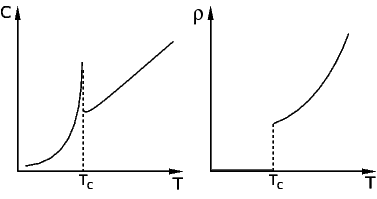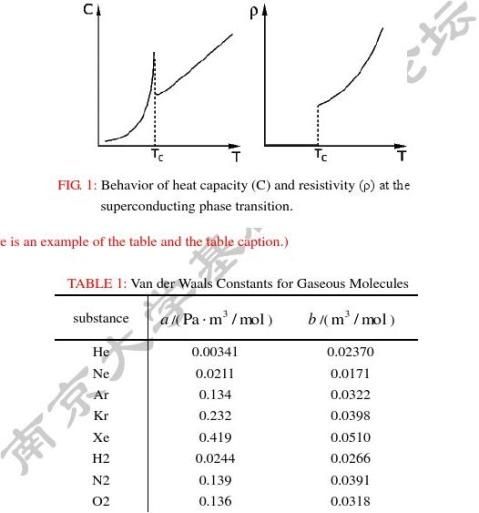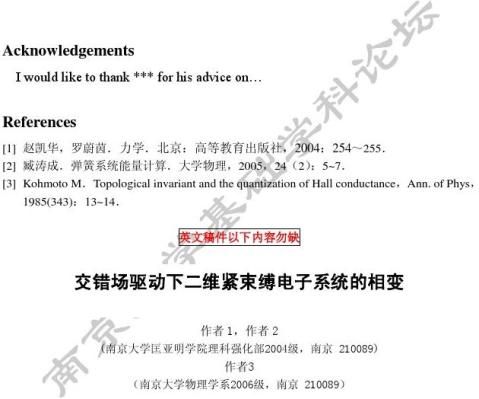英文论文格式说明及模版-南京大学
南京大学第十二届基础学科论坛
附件3:论文格式说明及模版(英文)
格式说明:
英文文章关键格式(按行文次序)如下,建议您在英文论文模板上直接行文。
1. 页眉、页码等同附件二中的要求1。所有英文字体须为Times New Roman,特殊名
词可用斜体。
2. 论文题目格式为“三号、加粗、居中”,请注意大小写。作者和导师信息格式参见
模板。作者名写法示例:“Zhao Qin”“Wang Jie-qiong”,作者字号为小四,个人信息字号为五号。信息若较长可分成两行,学院名和年级数须为全称。
3. “Abstract:”“Key words:”三个单词及冒号为“5号、加粗”,后面英文为5号。
4. 各级标题以§开头,并逐级展开(见模板)。格式为“四号、加粗、左对齐”。第二
级§1.1和更次级§1.1.1的标题格式一律为“小四、加粗、左对齐”。
5. 正文部分英文字号为“小四”,段落开头空出两个英文字母的格数。出现的数学参
数字母须为公式编辑器状态下的斜体英文(如参数A,a,B,Q,k)。
6. 编号
a) 图、表要有编号。英文格式为“FIG.1”“TABLE 1”,图号在图正下方,表号
在表正上方。可在“FIG.1:”“TABLE 1:”后附上适当文字描述,字号为5号。 b) 关于公式和文献的编号要求详见附件二中的5(b)(c)。
6. 可在“Conclusion”后适当附上“Acknowledgements”“Appendix”。
7. 参考文献详见附件二中的要求8。
8. 中文摘要、关键词。(请投递英文稿件的作者务必提供)
包括中文题目、中文姓名、作者和导师信息等,详见附件二中的要求2和3。
南京大学第十四届基础学科论坛 物理学
Staggered Field Driven Phase Transition in 2D
Tight-binding Electron System
Author 1, Author 2
(2004’, Department for Intensive Instruction, Kuang Yaming Honors School,
Nanjing University, Nanjing 210089)
Author 3
(2006’, Department of Physics, Nanjing University, Nanjing 210089)
Mentor: ×××
Abstract: A particular staggered-flux-driven quantum phase tight-binding
electron system is studied in detail…
(It’s recommended that the length of this abstract is not longer than one-third page.)
Key words: (You should add necessary semicolons and space, except for the ending word)
§1. Introduction
(Here you can mention what others have done about the subject you’re going to discuss. The following patterns are preferred.)
…the staggered[1]attention recently…
…the 2D Dirac been found to be the effective model of many [2][3] and…
§§
(Here is an example for equation. According to the structure of sentence,you should pay attention to the period or comma after the equation.)
Finally Einstein found that
E?mc2. (1) (Here is another example for equation. Because the sentence has ended,you don’t need to add any period or comma after the equation.)
We have obtained the definition of acceleration, and we put it below. dvd2sa?? dtdt2(2)
1
南京大学第十四届基础学科论坛
(Here is an example for inline equation.)
物理学
As we all know, the acceleration isa?dvdt?d2sdt2. Then…
§2.2 Title of Subsection … §2.2.1 Title of Subsection …
§3. Title of Section Three
(Here is an example of the figure and the figure caption.)


(Here is an example for referring to an equation, a figure and a table. You must notice that any meaningful parameter letter should be written in the form of formal equation, but not simply English letters.)
dA (3) dB
According to Eq.(3), we know thatCis the derivative ofAtoB. Beside this, [Fig.1] and [Tab.1] infer us that…
C?
2
南京大学第十四届基础学科论坛 物理学
§5. Conclusion(s) and Discussion(s)
(This section gives a brief summarizing of the results of the work. Sometimes, discussions to the results can be made too.)
Appendix I
(In some cases, in order to maintain the easy readability of the paper, appendices are needed. The appendices are supplements to the text. However, appendices should be avoided in general.) Appendix II

指导教师:×××
(南京大学化学化工学院,教授,南京 210093)
摘要: 本文详细讨论了在特殊的交流驱动下,二维紧束缚电子系统的相变问题。我们建立了
赝自旋的模型作为一种有效的模型来解释……
(This abstract should be the Chinese translation of the English abstract.)
关键字:交错场;紧束缚;相变
(These words should be the Chinese translation of the English key words. And you
should add necessary semicolons, except for the last word.)
3
第二篇:英语、英文论文格式、范文、模版
Idiom Translation under the Chinese
and English Cultures
Class XXX Number XXX Name XXX
Abstract: Nida, a famous translator, says, "For truly successful translation, it is much more important to familiarize two cultures than master two languages, because words are assigned meanings in its particular cultures."(Background information) This is to say, translation is closely related with not only languages but also cultures. Studies of the cultural distinction in idiom translation are still relatively weak in the field of translation in China. Exclusive research on the translation of Chinese and English idioms is still incomplete. In the last twenty years, idiom translation has mostly emphasized the level of inter-lingual communication, but cultural differences were rarely involved in it.(Identify problem) This thesis analyses the cultural differences in Chinese and English idioms, then studies English-Chinese\Chinese-English idiom translation methods(Research subject) from the angle of culture(Method) and points out some warnings concerning idiom translation: pay attention to context and choose the right version in line with the style and meaning of the original passage(Results); culture is a whole way of life, when new culture emerges, new idioms also appear, therefore idiom translation should develop with the time.(Conclusion)
Key Words: idioms; culture; translation
论英汉文化背景下的习语翻译
摘要:著名翻译学家奈达指出:“对于真正成功的翻译而言,熟悉两种文化甚至比掌握两种语言更为重要,因为词语只有在其作用的文化背景下才有意义。”也就是说,翻译不仅与语言有关也和文化有关。习语翻译中对文化差异的研究在中国的翻译领域中仍然较弱,专门对中英习语翻译的研究还不很完善。近20年来,习语翻译大多强调语际的交流,而很少涉及文化差异。本文通过分析中英习语的文化差异,进而从文化角度研究中英习语翻译方法,并指出中英习语翻译要注意的问题:联系上下文,选择与原文风格,意思相符的翻译;文化是一种生活方式,文化在变化,出现新的习语,习语翻译要与时俱进。
关键词:习语;文化;翻译
1. Introduction
Idioms universally exist in every language. An Idiom is a word or an expression that cannot be literally translated from the source language into the target language because its idiomatic meaning cannot be understood by literally defining its component parts.(Background) In a broad sense, idioms contain set phrases, proverbs, colloquialisms, slangs, maxims, allusions, etc. (YinLi, 2007:9) In Chinese, they also include enigmatic folk similes. Newmark, a British translation theorist, in his work A Textbook of Translation, said, "I define as culture the way of life and his manifestation that are peculiar to a community that uses a peculiar language as its means of expression. "(Previous research) English Idioms derives from English cultures and daily life. In real context, idioms explain themselves: nine times out of ten they carry their own explanations. If we are unaware of these, we will find ourselves in a state of confusion since we will assign literal meaning to them. The Chinese Idioms, especially the four-character idioms, have their own unique origins which are closely correlative to the Chinese history and cultures. In view of the difficulties in understanding idioms, we should pay due attention and efforts to understand their cultures and customs. This thesis is designed to dig into the cultural differences between Chinese and English and then elaborates on the translation theories applied to idioms. (Subject + Method)
2. A Comparison Between English and Chinese Idioms
2.1 The Cultural Differences Between English and Chinese Idioms
2.1.1 Geographical Conditions
The formation of culture is closely related with natural geographical conditions. A specific geographical environment produces a specific culture, which also leads to a particular expression.
Great Britain covers islands including the Northern one-sixth of the island of Ireland between the North Atlantic Ocean and the North Sea, northwest of France. It has a moist climate with much rainfall. Rivers and lakes are numerous. No wonder that fishery is thriving and most important in Britain. Accordingly, idioms concerning fish and navigation constitute a great part in English idioms. (LiYuping, 2008:20)(Theory/Results of previous research)
For example, "like a fish out of water". If you feel like fish out of water, you feel awkward and uncomfortable because you are in an unusual and unfamiliar situation. Fish in the air 缘木求鱼
An odd fish 怪人
Miss the boat 错过机会
Trim the sails to the wind 顺势前进
A small leak will sink a great ship 小洞不补要沉大船 (Examples)
On the other hand, China is located in the Asian Continent and reputed as an agricultural country with a large population of peasants. It is not surprising to find many idioms relevant to farming, such as "骨瘦如柴,对牛弹琴, 众人拾柴火焰高,竹篮打水一场空......". Chinese people also have a mysterious and awe feeling for sea, so they have idioms like "海角天涯,海枯石烂,海阔天空,海底捞针,海市蜃楼......". (Analysis)
2.1.2 History
………………………………………………………………………………. ………………………………………………………………………………. ……………………………………………………………………………….
2.2 The Similarities Between English and Chinese Idioms
……………………………………………………………………………….
……………………………………………………………………………….
……………………………………………………………………………….
2.2.1 Colours
……………………………………………………………………………….
……………………………………………………………………………….
……………………………………………………………………………….
……………………………………………………………………………….
2.2.2 Numbers
……………………………………………………………………………….
……………………………………………………………………………….
……………………………………………………………………………….
3. Methods of Idiom Translation
Translation is far more than a science. It is also a skill, and at the ultimate analysis, fully satisfactory translation is always an art. (Nida, 1982:49) Translation is considered as the cultural bridge and media between two languages. As there are wide differences in vocabulary and syntax between English and Chinese, translation is no easy job. Therefore, in order to keep the flavor of the original as well as cater for both the Chinese and English languages, translation skills should be reasonably employed in the process of translating, such as the following translating methods:
3.1 Literal Translation
……………………………………………………………………………….
……………………………………………………………………………….
……………………………………………………………………………….
3.2 Free Translation
……………………………………………………………………………….
……………………………………………………………………………….
……………………………………………………………………………….
3.3 Translation with Notes
……………………………………………………………………………….
……………………………………………………………………………….
……………………………………………………………………………….
3.4 Replacement with Similar Idioms
……………………………………………………………………………….
………………………………………………………………………………. ……………………………………………………………………………….
3.5 The Translation of Corresponding Idioms with the Same Meaning
………………………………………………………………………………. ………………………………………………………………………………. ……………………………………………………………………………….
3.6 A Combination of Literal and Free Translation
………………………………………………………………………………. ………………………………………………………………………………. ……………………………………………………………………………….
4. Some Warnings Concerning Idiom Translation
………………………………………………………………………………. ………………………………………………………………………………. ……………………………………………………………………………….
5. Conclusion
One of the major characteristics identifying us as human is our ability to use language. Language plays a very important role in people’s daily life; it enables people communicate with each other and understand others' feelings. Language has close relations with culture. It is impossible to separate language from culture. As the essence of language, idioms also have close relations with culture. The contents of them range from society, history, psychology to customs and other various social phenomena. So, in the process of translation, translators should pay more attention to the cultural factors, in doing this, he can dig up the implicit meanings. (Conclusion of research) Only the cultural factors are concerned, translators can have a satisfactory translation. Besides, people should get acquaintances with the cultural background when using idioms to avoid embarrassment in communication. (Suggestions)
References
[*] 作者. 书名(英语的斜体). (出版地:)出版社,年份:参考内容页码
[*] 作者. 文章名(英语的斜体). 刊物名称. (出版地:)出版社,年份
[1] Li Mei. Mother tongue and translation. Shanhai: Shanhai Foreign Language Education Press, 2008
[2] Li Qingming. A Comparison of the Cultures between the Chinese and English Language. Xi'an: Northwest University of technology Press, 2007
[3] Nida Eugene. The theory and Practice of Translation. Leiden: E. J. Brill, 1982
[4] Nida Eugene. Language, Culture, and Translating. Shanhai: Shanhai Foreign Language Education Press, 1993
[5] Susan Bassnett, Andre Lefevere. Translation, History, Culture. Shanghai: Shanhai Foreign Language Education Press, 1987
[6] Luo Shiping. A Research on English Idioms. Shanhai: Shanhai Foreign Language Education Press, 2006
[7] Li Yuping. English Idioms and their Cultural Origin. Tianjin: Nankai University Press, 2008
[8] Yin Li. English-Chinese Idioms and Folk Culture. Beijing: Bejing university Press, 2007
[9] Zhang Yajun. A Kaleidoscope of Chinese Culture. Beijing: Sinolingua, 2008\
[10] 李云(Li Yun).《新编大学翻译教程》. 北京:世界知识出版社, 2007
[11] 马爱英(Ma Aiying).《中英文化翻译》. 北京:科学出版社, 2006
[12] 孙致礼(Sun Zhili).《新编英汉翻译教程》. 上海:上海外语教学出版社, 2008
[13] 王宗炎(Wang Zongyan).《英汉语文问题面面观》. 北京:北京高等教育出版社, 2006
-
西安电子科技大学 论文格式
西安电子科技大学本科生毕业设计(论文)撰写规范一.毕业设计(论文)的总体要求:撰写论文应简明扼要,一般不少于15000字(外语专业…
-
大学毕业论文格式标准范本
附件3毕业论文格式标准范本浙江广专业毕业论文论文题目二号黑体居中学生姓名三号黑体学号三号黑体指导教师三号黑体专业三号黑体年级三号黑…
-
大学毕业论文格式与范文
石河子大学毕业论文题目:内部审计促进公司有效治理的理论分析院(系):石河子大学商学院财政金融系年级:20级专业:会计学班级:会计2…
-
论文标准格式范文
试论现代信息技术条件下高校两课教师角色的转变(辽宁大学外国语学院辽阳111000)内容提要:深化两课改革必须解决两课教学方法的科学…
-
大学论文标准格式
标准论文格式一包含内容1题目应能概括整个论文最重要的内容言简意赅引人注目一般不宜超过20个字论文摘要和关键词2论文摘要应阐述学位论…
-
英语论文模板(格式)
OnExtracurricularActivitiesandCultivationofEnglishCommunicativeAbilityofCol…
-
英语论文模板(格式)
OnExtracurricularActivitiesandCultivationofEnglishCommunicativeAbilityofCol…
-
英语论文格式范本
安徽农业大学毕业论文设计论文题目姓名学号专业指导教师职称中国合肥二oo年六月安徽农业大学学士学位论文设计开题报告ImageofNe…
-
英文论文格式规范模板
英文论文格式规范模板TitleTimesNewRomansize16ZHANGZhenling1AuthorName2Author…
-
英语论文格式范文
英语论文格式范文英语论文格式及写作规范语言和内容是评判一篇英语论文质量高低的重要依据但是写作格式规范与否亦是一个不可忽略的衡量标准…
-
英语论文格式及写作规范
英语论文格式及写作规范语言和内容是评判一篇英语论文质量高低的重要依据但是写作格式规范与否亦是一个不可忽略的衡量标准因此规范英语论文…